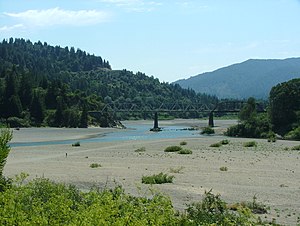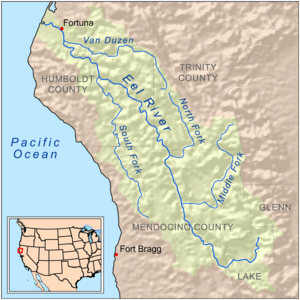
Back نهر الانقليس (نهر فى امريكا) ARZ Ийл Bulgarian Eel River (suba sa Tinipong Bansa, California, Humboldt County) CEB Eel River (Kalifornien) German Eel French Río Eel GL Eel River Italian Eel River SIMPLE Eel Nehri (Kaliforniya) Turkish ილი (კალიფორნია) XMF
| Eel River | |
|---|---|
 The river near Dyerville, California | |
 Map of the Eel River drainage basin | |
| Location | |
| Country | United States |
| State | California |
| County | Humboldt, Lake, Mendocino, Trinity |
| City | Fortuna |
| Physical characteristics | |
| Source | Pacific Coast Ranges |
| • location | Mendocino County, California |
| • coordinates | 39°36′51″N 122°58′12″W / 39.61417°N 122.97000°W[1] |
| • elevation | 6,245 ft (1,903 m)[2] |
| Mouth | Pacific Ocean |
• location | Humboldt County, California |
• coordinates | 40°38′29″N 124°18′44″W / 40.64139°N 124.31222°W[1] |
• elevation | 0 ft (0 m) |
| Length | 196 mi (315 km)[1] |
| Basin size | 3,684 sq mi (9,540 km2)[3] |
| Discharge | |
| • location | mouth, near Fortuna[4] |
| • average | 9,503 cu ft/s (269.1 m3/s)[4] |
| • minimum | 10 cu ft/s (0.28 m3/s) |
| • maximum | 935,800 cu ft/s (26,500 m3/s) |
| Basin features | |
| Tributaries | |
| • left | South Fork Eel River |
| • right | Middle Fork Eel River, North Fork Eel River, Van Duzen River |
| Type | Wild 97.0 miles (156.1 km) Scenic 28.0 miles (45.1 km) Recreational 273.0 miles (439.4 km) |
| Designated | January 19, 1981[5] |
The Eel River (Wiyot: Wiya't;[6] Cahto: Taanchow; Northern Pomo: ch'idiyu)[7] is a major river, about 196 miles (315 km) long, in northwestern California. The river and its tributaries form the third-largest watershed entirely in California, draining a rugged area of 3,684 square miles (9,540 km2) in five counties. The river flows generally northward through the Coast Ranges west of the Sacramento Valley, emptying into the Pacific Ocean about 10 miles (16 km) downstream from Fortuna and just south of Humboldt Bay. The river provides groundwater recharge, recreation, and industrial, agricultural and municipal water supply.[8]
The Eel River system is among the most dynamic in California because of the region's unstable geology and the influence of major Pacific storms. The discharge is highly variable; average flows in January and February are over 100 times greater than in August and September.[9] The river also carries the highest suspended sediment load of any river of its size in the United States, in part due to the frequent landslides in the region.[4] However, the river basin also supports abundant forests – including some of the world's largest trees in Sequoia sempervirens (Coastal redwood) groves–and, historically, one of California's major salmon and steelhead trout runs.
The river basin was lightly populated by Native Americans before, and for decades after, the European settlement of California. The region remained little traveled until 1849, when Josiah Gregg and his exploring party arrived in search of land for settlement. The river was named after they traded a frying pan to a group of Wiyot fishermen in exchange for a large number of Pacific lampreys, which the explorers mistook for eels.[10]: 91 [11] Explorers' reports of the fertile and heavily timbered region attracted settlers to Humboldt Bay and the Eel River Valley beginning in 1850. Starting in the late 19th century the Eel River supported a large salmon-canning industry which began to decline by the 1920s due to overfishing. The Eel River basin has also been a significant source of timber since the days of early settlement, and continues to support a major logging sector. The river valley was a major rail transport corridor for the Northwestern Pacific Railroad beginning in 1914 and continuing throughout the 20th century, and also forms part of the route of the Redwood Highway (US Highway 101).
Since the early 20th century, the Eel River has been dammed in its headwaters to provide water, via interbasin transfer, to parts of Mendocino and Sonoma Counties. During the 1950s and 1960s, there was great interest in building much larger dams in the Eel River system, in order to provide water for the State Water Project. Although the damming would have relieved pressure on greater California's overburdened water systems, it stirred up decades of controversy, as some of the proposals made little economic sense and would have been detrimental to an ailing salmon run. The Eel was granted federal Wild and Scenic River status in 1981, formally making it off-limits to new dams.[12] Nevertheless, logging, grazing, road-building, a burgeoning cannabis industry, and other human activities continue to significantly affect the watershed's ecology.
- ^ a b c "Eel River". Geographic Names Information System. United States Geological Survey. 28 November 1980. Retrieved 20 January 2011.
- ^ Source elevation derived from Google Earth search using GNIS source coordinates.
- ^ About the Eel River Archived 19 July 2007 at the Wayback Machine, Friends of the Eel River
- ^ a b c Lisle, Thomas E. "The Eel River, Northwestern California: High Sediment Yields from a Dynamic Landscape" (PDF). United States Forest Service. Retrieved 14 December 2013.
- ^ "National Wild and Scenic Rivers System". rivers.gov. National Wild and Scenic Rivers System. 5 January 2023.
- ^ Elicitation of miscellaneous words and phrases. Includes minimal pairs and contrasts., LA 23.018, in "The Stuart Fletcher and Karl V. Teeter collection of Wiyot sound recordings", Survey of California and Other Indian Languages, University of California, Berkeley, http://cla.berkeley.edu/item/16469
- ^ "Basic Database Searching, cahtotext database". Retrieved 7 July 2012.
- ^ William M. Brown and John R. Ritter, Sediment transport and Turbidity in the Eel River Basin Archived 24 December 2013 at the Wayback Machine, 1971, prepared in cooperation with the California Department of Water Resources, 67 pages.
- ^ Cite error: The named reference
NWISwas invoked but never defined (see the help page). - ^ Bledsoe, Anthony Jennings (1885). Indian Wars of the Northwest: A California Sketch. Bacon.
- ^ Bright, William; Gudde, Erwin G. (1998). 1500 California Place Names: Their Origin and Meaning. University of California Press. p. 51. ISBN 0-520-21271-1.
- ^ "National Wild and Scenic Eel River", The Eel River Reporter, Friends of the Eel River, Vol. VIII, Summer 2005 p. 14.